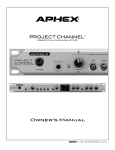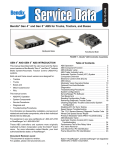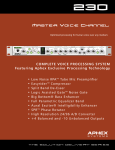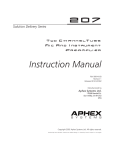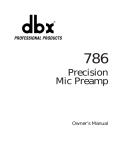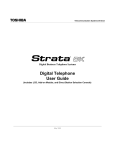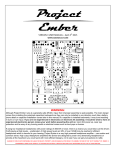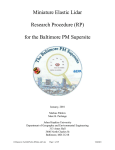Download Aphex Channel Owner`s manual
Transcript
CHANNEL™ MASTER PREAMP & INPUT PROCESSOR THE COMPLETE CHANNEL STRIP FOR VOICE AND INSTRUMENTS Owner’s Manual SAFETY DECLARATIONS CAUTION: For continued protection against risk of fire, replace only with the same type and rating of fuse. ATTENTION: pour une protection continue contre les risques d’incendie, ne remplacer qu’avec la même valeur et même type de fusible. WARNING: Do not place objects containing liquid on this unit as it is not designed to protect against spillage. Do not expose this unit to dripping or splashing of liquids as the unit is not designed to protect against these occurances. WARNING: This unit must be connected to a mains socket outlet with a protective earthing connection. WARNING: The Exciter has been tested and meets the FCC, CE and European Union rules, regulations, and guidlines for use. Do not attempt to modify or change the Exciter, as this could void the regulator y compliance, which would place you at risk of losing your authority to operate the Exciter. WARNING: Do not place objects on top of this unit if they weigh more than 10 pounds. This equipment has been tested and found to comply with the limits for a Class B digital device, pur suant to part 15 of the FCC rules. These limits are designed to provide reasonable protection against harmful inter ference in a residential installation. This equipment generates, uses and can radiate radio frequency energy and, if not installed and used in accordance with the instructions, may cause harmful interference to radio communications. However, there is no guarantee that interference will not occur in a particular installation. If this equipment does cause harmful interference to radio or television reception, which can be determined by turning the equipment off and on, the user is encouraged to try to correct the interference by one or more of the following measures. 1. Reorient or relocate the receiving antenna. 2. Increase the separation between the equipment and receiver. 3. Connect the equipment into an outlet on a circuit different from that to which the receiver is connected. 4. Consult the dealer or an experienced radio/TV technician for help. Page 2 TABLE OF CONTENTS 1.0 CONTROLS & INDICATORS 2.0 INSTALLATION AND INTERFACING 2.1 Installation 2.2 AC Line Connection 2.3 Mic Input Connections 2.4 Insert Jacks 2.5 Output Connections 2.6 Digital Audio Outputs 2.7 Word Clock 2.7.1 INT/EXT 2.7.2 WC IN 2.7.3 WC OUT 2.7.4 Local Clock Mastering 2.8 Power Supply 2.9 Cough Switch 3.0 USING THE CHANNEL 3.1 Using the Mic Input 3.2 Using the Instrument Input 3.3 Using Phantom Power 3.4 Using the Polarity Switch 3.5 Using the Pad 3.6 Using the Low Cut 3.7 Using the Phase Rotator 3.8 Using the Compressor 3.9 Using the Logic Assisted Gate 3.10 Using the De-esser 3.11 Using the Equalizer Block 3.11.1 Big Bottom 3.11.2 Parametric Equalizer 3.11.3 Aural Exciter 3.12 Using the Level Control 3.13 Clip Light 4.0 WARRANTY AND SERVICE 4.1 Limited Warranty 4.2 Service Information 5.0 SPECIFICATIONS 5.1 General Specifications 5.2 Architectural Specifications 5.3 Patent Notice 4 6 6 6 6 7 7 7 7 7 7 7 7 7 8 8 8 8 9 9 9 9 9 10 10 10 10 10 10 10 11 11 12 13 14 Copyright 2011 by Aphex. All rights reserved. All Aphex products are trademarks or registered trademarks of Aphex. Other brand and product names are trademarks or registered trademarks of their respective holders. Page 3 1.0 CONTROLS AND INDICATORS POWER INDICATION The Aphex logo above the power switch glows yellow during the tube preamp’s warm-up time and green when the unit is ready. LOW NOISE MIC PRE The Channel works with all professional microphones. The clean and stable 48V phantom supply is suitable for even the most expensive microphones. The 12dB/octave low cut filter starts at 70Hz to effectively reduce wind blast without diminishing voice body. Included is a selectable phase rotator following the principles of the Spectral Phase Refractor (SPR) circuit. The main benefit of the Phase Rotator is that by making certain voice waveforms more symmetrical, the compressors action becomes more efficient. This allows for a more optimized output level. COMPRESSOR The Channel includes a special version of Aphex’s patented Easyrider™ Compressor which has proven to be outstanding. It is very simple to use with only two controls: Gain/Drive and Release. To get deeper compression, turn up more Gain. To manage the density and loudness, work with Release. Faster is louder and denser. Slower is more natural and open. Note that turning up the Gain/Drive to get more compression alters the overall gain structure through the device such that the output may need compensating adjustment. DE-ESSER Using a split-band technique with Linkwitz-Riley crossovers, the voice remains bright and sharp, never losing presence while de-essing. The de-ess threshold control lets you chose the essing level that you want. EQUALIZATION BLOCK A fully parametric equalizer band is provided along with the popular Aphex Big Bottom and Aural Exciter. These features increase power, punch and intelligibility without adding noise or an increase in output level. As a real plus, they are also very easy to adjust. REAR INSERT JACK Allows you to insert any kind of line level audio equipment into the signal path between the Channel’s dynamics processing and the equalizer section. The operating level at this jack is 0dBu. You should set up your inserted outboard gear accordingly. METERS Meters are provided for peak output level (relevant to both analog and digital headroom at 0dB = max before clip) and the compressor’s gain reduction. The output level bar graph will move upwards indicating level, and the gain reduction bar graph will move downwards indicating gain reduction. OUTPUT CONTROL LOGIC ASSISTED GATE™ Once triggered, even by a microscopic transient, the signal progresses fully through the attack, hold, and release sequence. This virtually eliminates the chatter experienced with other gate products. The attenuation depth and gating threshold are user adjustable to allow for varying requirements. Once all processing and equalization is set where you want it, the output level may need to be adjusted. Do not let the peak level frequently exceed -6dBFS. This will make sure the digital output carries well through subsequent mixing and processing. When using the analog output, adjust the level to produce the desired average output level (0VU) as seen on the outboard equipment’s meters. 48V When pressed, turns on the microphone phantom 48V power IINSTRUMENT INPUT Allows connection of a guitar or bass. Page 4 GAIN/DRIVE Adjusts preamp gain and drive into the compressor. Lo Cut Switches on the 70Hz Low Cut filter. Invert Polarity When pressed, inverts the polarity (phase) of the mic input. CLIP/MUTE Flashes yellow when the preamp is muted by the cough switch. Flashes red indicating clipping. Phase Rotator Enables the Spectral Phase Refractor to improve speech symmetry. PAD When pressed, turns on the 20dB input pad. Compressor Turns on the Easyrider compressor circuit. GATE THRESHOLD When the sound is higher than this level, the gate opens up instantly. No “chattering” thanks to the patented Logic Assisted Gate. RELEASE Controls the density of compression. Slow for natural leveling and fast for more loudness. REAR PANEL ANALOG CONNECTIONS BALANCED TRS MIC INPUT Works with all standard microphones, phantom powered or passive. Phantom power activated from front panel. +4dBu Balanced XLR Output Line Level Processor, i.e., Compressor, EQ -10dBV/+4dBu switchable TRS Output COUGH SWITCH Allows you to silently mute the output on the fly using a handheld, desktop, or floor switch. REAR PANEL DIGITAL CONNECTIONS DIGITAL AUDIO The Channel supplies industry standard stereo AES/EBU, S/PDIF, and TOSLINK digital audio outputs. The single mic channel appears on both stereo channels as a mono signal. Sample rate and word clock options are all available at the front panel. The word clock selection LEDs will flash when no clock signal is present and light solid when locked. DEPTH Lets you set how much attenuation the gate will deliver. Use the lowest attenuation that’s needed to reduce room wetness, breath, or background noise. Usually 6 to 15dB is sufficient. Fully CCW is off. GATING Shows when the gate is closed or closing. When the light is off, the gate is fully open. DE-ESSING Shows when the the de-esser is working. When the light is on, sibilance is being controlled. DE-ESS THRESHOLD Lets you set the level where you want your esses to level off. AES/EBU OUTPUT Digital 110 Ohm cables only. (Do not use regular audio cables.) S/PDIF & OPTICAL OUTPUTS All outputs are active at the same time. WORD CLOCK BNC input and output jacks. PARAMETRIC EQ Works like a standard parametric band with tune, Q, and boost/cut controls. BIG-BOTTOM FREQ Adjusts the frequency below which enhancement takes place. BIG-BOTTOM AMOUNT Adjusts the strength (boost) of the Big Bottom effect. AURAL EXCITER FREQ Adjusts frequency above which enhancement takes place. AURAL EXCITER AMOUNT Adjusts the strength (boost) of the Aural Exciter effect. BB/EQ/AX ON Switches the BB/EQ/AX on/ off. Provides full true bypass of the circuits when off. OUTPUT Adjusts the final processed output level as seen on the VU meter. WHY YOU SHOULDN’T CONNECT THE CHANNEL’S OUTPUT TO A MIC LEVEL INPUT. The bottom line: you will get an unsatisfactory noise level. The Channel is designed to generate a line level output from a mic level input. It optimizes the signal to noise ratio by giving you a strong signal far above the preamplifier’s basic self noise level. This strong output signal can be up to 65dB higher than the mic signal. It is perfect for a standard line input of a mixer or console but can overload a mic input. If you have no other choice but to plug the Channel in to a mic input, turn that mic input’s gain all the way down. If the signal still clips the input, try bringing down the Channel output level. Page 5 2.0 INSTALLATION & INTERFACING 2.1 INSTALLATION The Channel occupies a single rack space (45mm or 1-3/4 inches) of a standard EIA equipment rack. When rack mounting, use appropriate cushioned rack screws. Never restrict air flow through the device’s vents. When installing the units into a rack, distribute the units evenly. Otherwise, hazardous conditions may be created by an uneven weight distribution. Connect the unit only to a properly rated supply circuit. Reliable earthing (grounding) of rack mounted equipment should be maintained. Try not to position the Channel directly above devices that generate excessive heat such as power amplifiers (unless adequately ventilated) or near equipment with heavy transformer hum fields. REAR PANEL VIEW 2.2 AC LINE CONNECTION Use only a power cord that carries approvals for use in your location. The Channel’s internal power supply is designed to operate from all nominal power sources from 100 to 240 volts a.c. at 50/60Hz without requiring the user to change any settings. In case of failure, do not attempt to change the internal fuse because it will never blow unless the power supply fails catastrophically. The power supply will need to be serviced by a competent service technician in such a case. 2.3 MIC INPUT CONNECTION The microphone input connector is located on the rear panel. It is the standard XLR-3F type. Use only properly wired balanced mic cables. PROPER MICROPHONE CABLE WIRING CAUTION: Some ribbon mics will be damaged by phantom power, some ribbon mics require phantom power and some just ignore it. Please consult your ribbon mic’s manual before connecting it to the Channel. CAUTION: Beware that 48 volt PHANTOM POWER may be applied to the microphone input, creating a potential shock hazard. Shut off the phantom power before plugging or unplugging microphones, waiting at Page 6 least 10 seconds for the voltage to fall. This also protects sensitive microphones against power inrush. 2.4 INSERT JACKS The Channel allows you to insert additional signal processing between the Channel’s dynamics processing and the equalizer block. Both Send and Return jacks are balanced and run at 0dBu. This is a perfect place to insert an external reverb unit or profanity delay, but you have the option to put anything there that you wish as long as it returns a nominal level. Direct feed-through occurs with the normalling contacts of the jacks. If you plug into either the SEND or RETURN jack, the internal path is interrupted. You need to be sure you have a viable send-return circuit externally or there will be no audio output from the Channel. There is no insert bypass switch. Once plugged in, the insert is always inserted. If you can’t get any output from the Channel, make sure the inserted gear is operating. 2.5 OUTPUT CONNECTORS There are two output connectors located on the rear panel: one 1/4” TRS phone type and one XLR-3M type. They can be used at the same time to feed separate equipment. The output level at the XLR is +4dBu impedance balanced, while the TRS balanced/unbalanced jack is switchable between -10dBV (consumer level) and +4dBU (professional level). If you intend to make an unbalanced output from the XLR jack, simply take “hot” from pin 2 and use pin 1 for ground. Leave pin 3 unconnected or grounded. Never ground pin 2. XLR: DIGITAL OUTPUT DEFINITIONS AES/EBU 110Ω @ 5Vp-p RCA: S/PDIF 75Ω @ 1Vp-p OPTICAL: Toslink S/PDIF encoded for optical fiber. 2.6 DIGITAL AUDIO OUTPUTS The processed mic signal is converted to digital in both channels at equal level as a mono signal. There is no provision to externally drive one of the A/D Converter inputs. 2.7 WORD CLOCK 2.7.1 Clock Select Synchronization is selected by the Clock Select button on the front panel. Sample rates of 44.1, 48, 88.2 or 96kHz are supported. output. A word clock distribution device should be used in systems with multiple digital devices. 2.8 POWER SUPPLY The Channel is internally powered from a standard IEC power receptacle on the rear panel. Be sure you use a power cord that is approved for use in your jurisdiction. Soft-start, overload foldback limiting, and accros-theline voltage spike protection is incorporated to protect the power supply from damage that might be caused by component failure or power line disturbances. If the internal fuse blows out, a catastrophic failure has occurred and simply replacing the fuse will not fix the problem. Due to the extensive protective measures used, it is highly unlikely a catastrophic power supply failure will ever occur. However, if it does, you should contact the factory or a competent service technician to affect repairs. There are no user serviceable parts inside. ACCEPTABLE POWER RANGE 100 to 240V~, 50 to 60Hz 2.9 COUGH SWITCH Voice artists/actors often find it necessary to clear the throat, sip a beverage, or cough during narration. Thus, a convenient mute and unmute jack is provided. Any standard momentary or latching foot pedal or switch wired to a mono phone plug will work. Usually, a desktop box mounted silent pushbutton is preferred, as it can be accessed most readily. 2.7.2 Word Clock IN This BNC jack is provided to receive your master clock source. It will accept industry standard Word Clock, from less than 1 to over 5Vp-p pulse amplitude. It does not accept AES/EBU or Superclock. 2.7.3 Word Clock OUT The Channel provides a very accurate internal word clock generator. When using the Channel as a clock master, the word clock signal is sent from the BNC word clock output. Note that the Channel does not support word clock THRU. External clock signals received at the BNC input are not routed to the BNC Page 7 3.0 USING THE CHANNEL FRONT PANEL VIEW 3.1 USING THE MICROPHONE INPUT The Channel is perfect for all types of microphones, either powered or not. We encourage you to try every mic you own with the Channel. Many features of the Channel are standard with all professional preamps - polarity - pad - etc. Some features are unique and we hope you will fully exploit them. 3.2 USING THE INSTRUMENT INPUT The Channel can also be used as a high quality direct box. When an instrument cable is plugged in to the Instrument input on the front panel, the rear panel XLR input is bypassed. This allows the user to keep a microphone connected to the rear panel and simply insert an instrument cable in to the front panel instrument input when D.I. functions are required. You will be able to achieve proper input levels no matter what kind of pickups are used. Single coil passive pickups will work just as well as active humbuckers. CAUTION: Some ribbon mics will be damaged by phantom power. Some ribbon mics require phantom power and some just ignore it. Please consult your manual before connecting a ribbon mic to the Channel. 3.3 USING PHANTOM POWER Active microphones that take power through the standard mic cable fall into a class called “phantom powered” mics. The power is called “phantom” because it rides the mic cable invisibly, without interfering with the audio signal carried on the same wires. 3.4 USING THE POLARITY SWITCH There will be times when you need to reverse the polarity (phase) of a mic signal. Vocalists monitoring themselves on headphones will hear a different sound when the phase is reversed. The reversed phase may sound fuller and more truthful or hollow and far away. That is because there is a cancellation of frequencies within the ear when the external sound from the headphone mixes with the sound directly conducted to the ear. “Flipping the phase” can make the problem either more or less noticeable. The industry standard phantom power source is positive 48 volts d.c. supplied to pins 2 and 3 through precision low noise 6.81KΩ resistors. You may note from spec sheets that many mics rated for phantom power actually run at something less than 48 volts. Don’t let these specifications confuse you. They all run perfectly well off the standard 48V phantom power source. Another time when phase reversing can be helpful is when using multiple microphones on the same source. For example, using two microphones on a guitar speaker cabinet. You may get a “nasal” or hollow effect when both mics are on. Changing the polarity of one mic will often clear up the problem. It is always worth the time to experiment with mic polarity. Plugging and Unplugging a microphone when phantom power is on can sometimes be dangerous. Some microphones can be damaged by power inrush. Switch off the phantom power first. Wait for the mic go silent before unplugging. Page 8 You should be aware of the shock hazard with the phantom power system. Long, open mic cables that are disconnected from the preamp while phantom is on can hold a d.c. charge for long periods of time, sometimes days, weeks or months. They will act as a storage capacitor and you can get shocked most rudely by holding the XLR plug and touching the pins inside. Also beware of microphone patch bays that may carry phantom voltage. Don’t hold the patch cord by the metal parts, only the plastic shell. Distance to Mic2 Distance to Mic1 = Sound Cancelled Figure 4-2 Phase Cancellation Effect 3.5 USING THE PAD An input pad is nothing more than a resistive attenuator that drops the level coming from the input. Its purpose is to give you a way of preventing overload of the preamp when incoming signals become excessive. In the Channel, we provided a pad of 20dB. That means when the pad is on, the net gain of the preamp is 20dB lower. There are times that the input may be overloaded even with the GAIN control set all the way down. For example, a bass player with active pickups and an aggressive playing style might peak the instrument input. Or a microphone on a kick drum or snare drum could do it. Engage the pad and 20dB of headroom will be provided allowing you to better control the input signal. 3.6 USING LOW CUT In the real world, mics pick up all sorts of unwanted low frequencies such as handling noise, wind rumble, or lectern thumps. We designed into the Channel a very effective way of cutting out these low frequencies. Switching on the LOW CUT FILTER rolls off all frequencies below 70Hz at 12dB per octave but places a slight compensation around 120Hz to improve the low end phase distortion and perception of remaining bass. 3.7 USING THE PHASE ROTATOR The Channel’s phase rotator is designed to help reduce high asymmetric peaks that can occur with certain audio waves. By reducing the amplitude of asymmetric peaks, the signal can ride louder through compressors and limiters. body-conducted sound mixes with the sound from the headphones. When the phase relationship of the two sounds changes, there will be partial to full cancellation at various frequencies. You should evaluate the phase rotator by auditioning recorded tracks made with and without the rotator. It should also be noted that the effects of the Phase Rotator are program dependant and results should be evaluated with any new signal. 3.8 USING THE COMPRESSOR The Channel’s compressor is very simple to use. Nevertheless, it is more sophisticated than compressors with many more controls. The Easyrider compression automatically adapts to audio waves in a manner that greatly reduces any pumping effect while it tightens the average level very flatteringly. There is only one obvious control: RELEASE. However, the mic pre’s GAIN control doubles as the compression drive adjustment. To get more compression depth, run up more gain. The RELEASE control allows you to chose the aggressiveness of the compression. For thick and loud, go faster. For more natural and “open”, go slower. The gain reduction is displayed on the Channel’s 10 segment bargraph meter. You may need to boost the output level to compensate for the gain reduction of the signal. 3.9 USING THE LOGIC ASSISTED GATE Aphex’s Logic Assisted Gate solves many common workflow problems when using gates. The Channel’s gate trigger is absolutely positive because it’s independent from the energy content of the sound peak. The slightest exceeding of the threshold by the soundwave triggers the logic that forces the gate’s attack-holdrelease sequences to perform completely and repeatabely. That makes finding the right threshold fast and easy. All you need to set are the threshold and depth of gating. Some words of advice: When doing voice work while wearing headphones, the Phase Rotator will affect how you hear yourself even though it is not affecting the actual sound of your voice. That’s because the Page 9 If you want complete silence between phrases, then use the maximum depth. However, if you simply want to bring down ambience pickup as with multiple open mics in a room, then use minimal depth. The Gating LED is triggered when the audio signal is below the Threshold. If the Threshold is turned all the way up, the LED may never light. If the Depth is turned all the way counter clockwise no gating will occur. However, because the LED is triggered from the Threshold the LED can be on even though the gate is inactive. 3.10 USING THE DE-ESSER Certain mics are too harsh in the upper range and some sounds tend to whistle or splatter. Conventional de-essers simply detect the presence of any frequency above a certain tuning point and duck the whole signal accordingly. The Channel’s de-esser is different. It uses split band techniques to attenuate only the sibilance, while leaving the body of the sound alone. Operation of the de-esser is simple. Just set the threshold to the point where you want the esses to limit out. Reducing the threshold setting brings down the level of the esses dynamically. In other words, it’s like an automatic downward shelving equalizer. It stays flat until the ess level gets too high and then introduces the shelf at the level needed to limit the sound to the threshold level. When there is de-essing, the LED is lit. 3.11 USING THE TONE ENHANCEMENT BLOCK Once the signal passes through the compressor, gate and de-esser, it encounters the Big Bottom low frequency enhancer, parametric peak/dip section, and the Aural Exciter top end enhancer. The whole block is bypassable with the BB/EQ/AX on/off push button. 3.11.1 BIG BOTTOM Some signals have no low bottom end. In such cases, the Big Bottom won’t synthesize a new low end for you and it should not be used. However, voices that contain a deep chest resonance can be augmented by the Big Bottom. Start by turning up the BB Amount to 12:00. Then adjust the BB FREQ to find a frequency that lifts the bottom. Last, reduce the BB Amount until just the right touch of bass enhancement is felt. 3.11.2 PARAMETRIC EQUALIZER This is a familiar and conventional EQ section. You can adjust the boost/cut, frequency selection and Q. Page 10 3.11.3 AURAL EXCITER Clarity, presence, and loudness can all be enhanced by the Aural Exciter. Start with the AX amount at 12:00. Next, sweep the FREQ to find the best tonal balance. Presence is best augmented with lower settings. Air is added with higher settings. Finally, readjust the AX Amount for the right amount of brilliance. Be conservative. Use the BB/EQ/ AX on/off switch to compare the original signal to the enhanced signal. 3.12 USING THE OUTPUT LEVEL CONTROL Once all the processing is set, the output level may need to be adjusted. Change the OUTPUT control to obtain peaks that don’t go above -6dBFS on the output meter. Check the input meter of the device the Channels output is plugged in to. If the input device is clipping, first turn the input devices gain control down. If the input is still clipping, bring the OUTPUT level of the Channel down to compensate. Be sure that the operation level of each device is set properly at either -10dBV or +4dBu. 3.13 CLIP/MUTE LIGHT If the LED is flashing RED, then the internal operating level is too hot. This can only occur if the insert return signal is too hot or if the parametric equalizer is boosted way too much. This same LED will also flash yellow while the Channel is in the MUTED state activated by the COUGH SWITCH (rear panel jack). 4.0 WARRANTY & SERVICE 4.1 LIMITED WARRANTY PERIOD One year from date of original purchase. SCOPE All defects in materials and workmanship. The following are not covered: Voltage conversions , units on which the serial number has been defaced, modified or removed. Damage or deterioration resulting from: Installation and/or removal of the unit; Accident, misuse, neglect, unauthorized product modification; Failure to follow instructions in the Owner’s Manual, User Guide or other official Aphex documentation; Repair or attempted repair by anyone not authorized by Aphex; Shipping damage – claims must be presented to the shipper WHO IS PROTECTED This warranty will be enforceable by the original purchaser and by any subsequent owner during the warranty period, so long as a copy of the original Bill of Sale is submitted whenever warranty service is required. WHAT APHEX WILL PAY FOR All labor and material expenses for covered items. Aphex will pay all return shipping charges if the repairs are covered by the warranty. LIMITATION OF WARRANTY No warranty is made, either expressed or implied, as to the merchantability and fitness for any particular purpose. Any and all warranties are limited to the duration of the warrant stated above. EXCLUSION OF CERTAIN DAMAGES Aphex liability for any defective unit is limited to the repair or replacement of said unit, out our option, and shall not include damages of any kind, whether incidental, consequential, or otherwise. Some states do not allow limitations on how long an implied warranty lasts and/or do not allow the exclusion or limitation of incidental or consequential damages, so the above limitations and exclusions may not apply to you. This warranty gives you specific rights which vary from state to state. 4.2 SERVICE INFORMATION If it becomes necessary to return this unit for repair, you must first contact Aphex Systems, Ltd. for a Return Authorization (RMA number), which will need to be included with your shipment for proper identification. If available, repack this unit in its original carton and packing material. Otherwise, pack the equipment in a strong carton containing at least 2 inches of padding on all sides. Be sure the unit cannot shift around inside the carton. Include a letter explaining the symptoms and/or defect(s). Be sure to reference the RMA number in your letter and mark the RMA number on the outside of the carton. If you believe the problem should be covered under the terms of the warranty, you must also include proof of purchase. Insure your shipment and send it to: APHEX 3500 N. San Fernando Blvd. Burbank, CA. 91505 USA PH: 818.767.2929 FAX: 818.767.2641 Page 11 5.0 SPECIFICATIONS 5.1 GENERAL SPECIFICATIONS INPUT Connector: Type: Input Z: Instrument Connector: Instrument Input Z: Type: Maximum Input Level (MIL): CMRR: Nominal Preamp Gain: Phantom Power: Pad: XLR-3F Transformerless, NPN active balanced, tube second stage 2KΩ nominal 1/4” TS 10MΩ nominal Transformerless, NPN active balanced, tube second stage 0dBu Greater than 70dB @ 60Hz 20 to 65dB +48VDC 20dB OUTPUT Connector: Type: Output Z Balanced: Output Z Unbalanced: Nominal Level Maximum Output Level (MOL): XLR-3M and TRS 1/4” phone jack XLR is Impedance Balanced (may be used unbalanced); TRS is unbalanced. XLR: 66Ω XLR: 33Ω − TRS: 600Ω XLR: +4dBu; TRS: -10dBV XLR: +25dBu Unloaded; TRS: +11dBV COMPRESSOR Attack/Release: Ratio: Threshold: Knee: Program dependent, user variable release baseline. 4:1 Fixed Medium Hard GATE Attack: Hold/Release: Threshold: Depth: 0.1 millisecond 300 milliseconds/400 milliseconds Variable -50 to +20dB Variable, 1 to 58dB DE-ESSER Attack: Release: Threshold: Raio: Active Band: 0.1 millisecond 100 milliseconds Variable -20 to +20dB 5:1 4.KHz to 20KHz Linkwitz-Riley 24dB/octave crossover INSERT Connector Type Send: Connector Type Return: Nominal Operating Level: Point of Insertion: 1/4” TRS Phone Jack, Balanced 1/4” TRS Phone Jack, Balanced 0dBu Between dynamics processing and equalizers. BIG BOTTOM Frequency Tune: MIx: 50Hz to 280Hz OFF to +12dB Frequency Tune: Peak/Dip: Q Range: 240Hz to 8KHz +/- 12dB 0.5 to 5 Frequency Tune: Mix: 500Hz to 5KHz OFF to +12dB PARAMETRIC EQ AURAL EXCITER ANALOG AUDIO THD: IMD: Freq Resp (FLAT): <.01% @ +4dBu Out <.01% @ +4dBu Out 18Hz to 24KHz +/- 1dB DIGITAL AUDIO Internal Sample Rates: External Sample Rates: Resolution: Word Clock Input: Word Clock Output: Dynamic Range: Noise Dither: Level Equivalency: 44.1KHz, 48KHz, 88.2KHz, 96KHz Automatically syncs to any word clock between 32KHz and 96KHz 24 Bits BNC Jack, High Z, Captures <1Vp-p to 5Vp-p BNC Jack, 75 Ohms, 5Vp-p Digital dynamic range greater than analog front end. Dithered by analog preamp noise floor. Equivalent to 16-bit digital audio dither. -20dBFS Digital = +4dBu Analog OTHER SPECS Power requirements: Power Consumption (maximum): Dimensions: Depth Behind Front Panel: Net Weight: Shipping Weight: Tube Type: 85 to 260V~, 50-60Hz 19 Watts 19” W x 1.75” H x 8.25” overall depth (482.6mm W x 445mm H x 209.6mm overall depth) 7.5” (190.5mm) Rack-mounted: 6lbs. (2.73kg) 9lbs. (4.1kg) 12AT7/ECC81 Dual Triode All specifications are subject to change without notice. Page 12 5.2 ARCHITECTURAL SPECIFICATIONS BASIC DESCRIPTION A single channel processor comprising microphone and instrument inputs, transformerless tube microphone preamp, a dynamics processing section and a tone controlling section, in that order. An insertion path shall be provided between the dynamics processing section and the tone controlling section. The microphone preamp shall comprise the following selectable functions: 1.) +48VDC Phantom Power; 2.) Polarity Reversal; 3.) Selectable 20dB Pad; 4.) Selectable 70Hz 12dB/Octave Low Cut Filter; 5.) Continuous Gain Control; 6.) Phase Rotator. The dynamics processing section shall comprise an adaptive dynamic range compressor, a logic assisted noise gate, and a split-band de-esser. The tone control section shall comprise a Big-Bottom bass enhancer, an Aural Exciter treble enhancer, and a single band parametric equalizer. PHYSICAL PROPERTIES The device shall be packaged in an all metal chassis measuring 19” (482.23mm) wide, 1.75” (44.42mm) high, with an overall depth of 8.25” (210mm). Depth behind the front panel shall be approximately 7” (178mm). The device shall have a net weight of approximately 6lbs. (2.73kg) and is capable of mounting in a standard electronic equipment rack. POWER The unit shall have a self contained power supply operating from the AC line. Primary voltage, connectorization and agency listings shall be appropriate to meet local requirements. Page 13 This product is protected under one or more of the following Aphex patents. 4578648, 4633501, 4843626, 4939471, 5115471, 5155769, 5334947, 5359665, 5422602, 5424488, 5450034 5463695, 5483600, 5485077, 5612612, 5737432, 5848167, 5896458, 5898395, 5930374, 6266423 3500 N San Fernando Blvd. Burbank, CA 91505 USA PH: 818.767.2929 FAX: 818.767.2641 www.APHEX.com ©Page 201214 Aphex LLC














